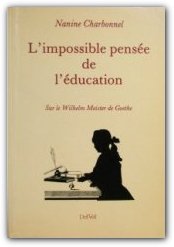Sur le Wilhelm Meister de Goethe

1987 Nanine CHARBONNEL,L'impossible pensée de l'éducation. Sur le Wilhelm Meister de Goethe, Cousset (Fribourg, Suisse) : Delval, 260 pages [éditeur disparu]
Wilhelm Meister ? Une œuvre capitale dans le destin de Gœthe : des Années d'Apprentissage (1795) à la fin des Années de Voyage (1829), sa création le préoccupe, si l'on tient compte d'une première version La Vocation théâtrale commencée en 1777, pendant plus de cinquante ans. Mais une œuvre capitale aussi dans le destin de l'Allemagne — peut-être de l'Europe : parangon du Bildungsroman, "roman d'apprentissage", "de formation", elle hante la pensée de l'éducation des deux siècles subséquents, de Hegel à Hermann Hesse, de Flaubert à Wim Wenders.
Littérature, pédagogie, philosophie ? Wilhelm Meister provoque chacun et ne plaît à personne. Et s'il était tout sauf un "roman d'éducation", à entendre par là une benoîte intégration ? Si son enjeu était la blessure et la rivalité, la doublure et la répétition, le supplément et l'originalité ? S'il ne légitimait la croyance aux dons innés que pour maintenir le système — génial — de son économie littéraire ? S'il disait — mensonge idéologique et vérité romanesque — quelque chose de caché depuis la fondation du monde (René Girard) ?
Voici, solidement argumentée, une thèse sur Wilhelm Meister qui bouleverse nos conceptions.

Une lecture:
"On lira encore la vigoureuse et décapante introduction de Nanine Charbonnel à son livre L’impossible pensée de l’éducation. Sur le «Wilhelm Meister» de Gœthe, Delval (Suisse), 1987; elle distingue la catégorie incontestable et très générale du « roman de
développement» (elle s’applique peut-être au roman stendhalien ou balzacien) du
Bildungsroman dont elle tend à nier l’existence et même la possibilité, en montrant comment le prototype unique de ce «genre» ne correspond pas à l’analyse de Lukács (il n’oppose pas l’idéal et le social, l’individu et la société, dans le divorce de l’intériorité et du monde), ni à celle de Dilthey (un personnage apprenti découvrant la vie, et avançant sur le chemin de la maturité et de l’harmonie); ni à toute interprétation par l’acquisition d’un enseignement; l’unique roman d’éducation serait étranger à la «Bildung», ce qui met en question le sens, l’usage possible de ce fameux concept, et la réduction de l’entreprise romanesque à une découverte de nature pédagogique (dans bien des cas,c’est une manière de réduire le roman à sa portée sociologique). On refusera en tout cas la mise en équivalence dans une synonymie impossible de la « Bildung», de la formation, de l’éducation, de l’apprentissage : les premiers et derniers termes ont sans doute un sens qu’il faudrait encore définir."
Michel Crouzet, ''Lucien Leuwen''. Le mentir vrai de Stendhal, Editions Paradigme, 1999, p.5